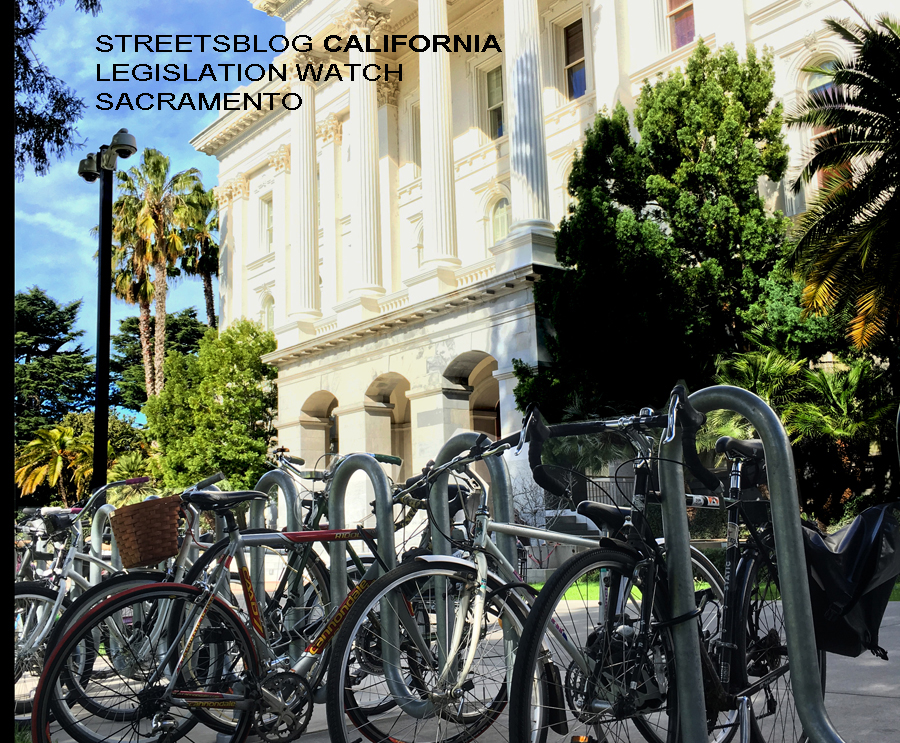Note: GJEL Accident Attorneys regularly sponsors coverage on Streetsblog San Francisco and Streetsblog California. Unless noted in the story, GJEL Accident Attorneys is not consulted for the content or editorial direction of the sponsored content.
The California legislative clock is ticking, and all bills must pass both houses or die by August 31, the end of the current two-year session.
Streetsblog is tracking a number of bills pertaining to transportation and housing, including the following:
Scooter Wars
While cities like Santa Monica are going through strange times trying to sort out what their policies should be around shared e-scooters, the legislature is doing the same work on state-level policy.
Streetsblog covered A.B. 2989 earlier. It began as an attempt to define e-scooters and took a stab at guiding locals on regulating them. The bill, from Assemblymember Heath Flora (R-Ripon), still does that, to an extent, but is much more limited than its first iteration. A.B. 2989, in its current form, would make two changes to the law: it would allow people over 18 years old to ride a scooter without a helmet, and would allow e-scooters to be ridden on streets that have a speed limit up to 35 mph but don't have bike lanes. It would make no changes to current law in terms of sidewalk riding or the top speed of scooters, which is 15 mph.
A.B. 2989 is currently waiting to pass the Senate, after which it can be sent to the governor. That should happen in the next week or so.
Speed Limits
Assemblymember Laura Friedman tackled a big issue with A.B. 2363: the misguided way California sets its speed limits. Streetsblog has written plenty about this bill: California law is so concerned with the possibility of local jurisdictions setting speed traps that it has bent over backwards to make it very hard for any municipality to lower speed limits. This has led to unintended consequences—if cities don't do an official survey of current speeds, they cannot enforce existing speed limits; but once they do a survey, they have to set limits based on how fast drivers currently go. That has led to speed limits going up over time just because people, feeling invulnerable in "safer" vehicles, generally drive faster than they used to.
Friedman's bill was trimmed severely in the process of making its way through the legislature. It now calls for a task force to develop policies to reduce traffic fatalities to zero. The task force would be required to analyze several traffic safety issues, including the existing process for establishing speed limits, and to make a recommendation to the legislature on whether an alternative practice should be considered.
The bill has had strong support from cities that are hampered in their attempts to enforce safe speed limits, and very little opposition—except from one person. The deceptively named Safer Streets L.A., a "drivers rights group" consisting of gadfly Jay Beeber, objected, and some of his arguments unfortunately were echoed in the bill's official analysis. For one, he objected to the name “Vision Zero Task Force,” a name associated with an "international movement" that "strives to protect pedestrians and bicyclists" and therefore “might tend to [be predisposed] to look for ways to reduce speed limits in more instances than might otherwise be justified.”
It's now the Zero Traffic Fatalities Task Force.
Parking
Another bill from Assemblymember Friedman passed both houses and is heading to the governor: A.B. 2263, which prevents local jurisdictions from requiring a developer to build more parking in the process of converting or adapting historical buildings, for example to convert them to housing. It is based in part on L.A.'s existing Adaptive Reuse Ordinance (ARO), which has been a huge success in making it easier to convert and reuse historic structures.
From the bill analysis:
According to one study, between 1999 and 2008 developers used the ARO to create about 6,900 housing units in downtown Los Angeles, primarily through conversion of existing historical office buildings. The author of that study surveyed 56 ARO developments and found that most developers said that the conversions would have been impossible without removing the parking requirements. Additionally, over a third of ARO buildings did not include parking in the price of their units, leading to savings on rent costs for many ARO residents.
The only “no” votes on this bill came from Republicans—which is strange. Why would advocates for less government interference want to require more parking than a building needs?
More updates to come. If there are specific bills you think Streetsblog should be tracking, let us know in the comments below.
Follow Streetsblog California on Twitter @StreetsblogCal






